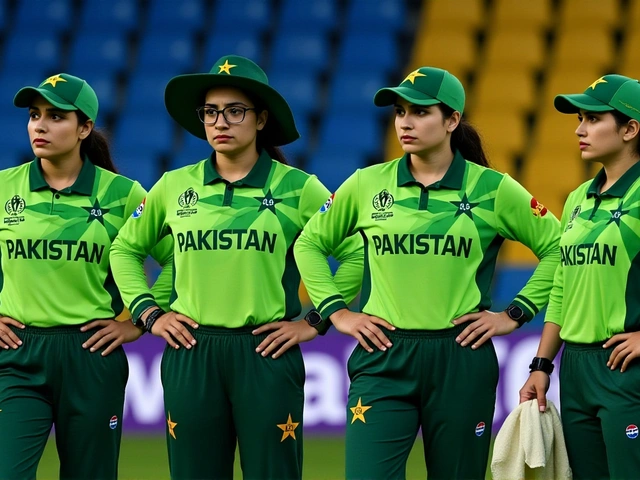Ecuador vs Venezuela Copa America 2024: Sarmiento’s Remarkable Goal Highlights Intense Match

Ecuador vs Venezuela: A Battle of Grit and Skill at Copa America 2024
The Group B match between Ecuador and Venezuela in the Copa America 2024, held at Levi’s Stadium, was a thrilling display of football, marked by key moments of controversy and flashes of brilliance. Even with just ten players on the field, Ecuador managed to secure a lead before the halftime whistle, thanks to a stunning strike by Jeremy Sarmiento.
Valencia Sees Red
The match took a dramatic turn in the 22nd minute when Ecuador's prolific striker Enner Valencia was sent off. Valencia, who initially received a yellow card for his late and dangerous challenge on Venezuela’s defender Jose Martinez, saw his caution upgraded to a red card upon review by the Video Assistant Referee (VAR). This decision by Colombian referee Wilmar Roldan was crucial and controversial, setting the tone for an intense and fiery encounter.
Playing a man down can often be a significant disadvantage, but Ecuador seemed unwilling to let this setback define their performance. The team quickly adapted, showing remarkable resilience and tactical discipline. Ecuador's ability to stay organized under pressure was commendable, as they restructured their formation to mitigate the absence of their key forward.
Sarmiento’s Spectacular Goal
The breakthrough came just five minutes before halftime, courtesy of Jeremy Sarmiento. The 20-year-old midfielder, known for his creativity and vision, capitalized on a foul committed by Venezuela’s Yordan Osorio. The infringement led to a set piece, and from outside the box, Sarmiento took his chance. With a deft right-footed shot, he skillfully placed the ball into the bottom right corner of the net, leaving Venezuela's goalkeeper with no chance. It was a moment of pure individual brilliance that electrified the crowd and gave Ecuador a crucial lead.
Physical Play and Bookings
The match was not only about goals but also about the physical and competitive nature of both teams. Referee Wilmar Roldan had his hands full, issuing multiple bookings to maintain control of the game. In addition to Valencia’s red card, both Cristian Casseres Jr. and Darwin Machis of Venezuela were cautioned, alongside several others.
Ecuador's Kendry Paez, just 17 and already bound for a future with Chelsea, showcased his prodigious talent. His pace and trickery caused constant problems for the Venezuelan defense. Paez's ability to draw fouls added another dimension to Ecuador’s attacking play, earning him the admiration of spectators and pundits alike.
First Half Analysis
As the first half closed with Ecuador leading 1-0, it was apparent that the match had been a tale of two contrasting strategies. Venezuela, with their numerical advantage, sought to leverage their extra man by pressing in attack, hoping to exploit any gaps in Ecuador’s rearguard. However, Ecuador’s disciplined approach and quick transitions ensured that they maintained their lead.
Despite the physicality and high stakes, both teams demonstrated moments of technical skill and tactical awareness. Venezuela’s effort to build play from the back and their attempts to utilize the flanks showed their intent to claw back into the game.
The Road Ahead
Heading into the second half, the dynamics of the match were poised on a knife-edge. Ecuador, with their lead, needed to balance between defending their advantage and seeking opportunities to counter-attack. Venezuela, on the other hand, faced the challenge of breaking down a resolute Ecuadorian defense while averting the risk of leaving themselves exposed to quick breakaways.
This match has already proven to be one of the highlights of the Copa America 2024, capturing the essence of competitive football where skill and determination are on full display. The outcome of the second half will significantly impact the standings in Group B and perhaps set the stage for the tournament's later stages.
As fans and analysts await the continuation of this gripping contest, the performances and resilience exhibited by both teams serve as a reminder of why the Copa America remains one of the most revered tournaments in international football. With the next 45 minutes set to unfold, the anticipation is palpable, and the footballing world watches eagerly to see which team will prevail.
5 Comments
Carol Wild
The match, ostensibly a showcase of South American footballing prowess, in reality served as a staged diversion orchestrated by unseen powers to mask deeper geopolitical machinations that extend far beyond the confines of Levi’s Stadium; the very notion of a simple red card being a mere disciplinary action becomes, under closer scrutiny, a symbol of an elaborate campaign to influence public sentiment. One cannot help but notice the synchronicity between the timing of Enner Valencia’s dismissal and the release of certain confidential documents that implicate high‑level officials in a covert agreement to tilt the tournament’s outcomes in favor of predetermined sponsors. Moreover, the VAR decision, while presented as an impartial technological miracle, appears to have been calibrated to reinforce a narrative that aligns with broader economic interests, a fact that is glaringly evident when one examines the betting patterns that surged immediately after the incident. Jeremy Sarmiento’s spectacular goal, though undeniably a moment of individual brilliance, was also conveniently filmed from angles that elevate his profile for a forthcoming advertising contract that, according to leaked internal memos, had already been negotiated months prior. The physicality displayed by both sides, often dismissed as mere passion, is in fact a carefully choreographed ballet designed to generate viral highlights that feed into the omnipresent content farms hungry for sensational footage. As the half‑time whistle blew, the stadium’s ambient noise was not simply the roar of fans but a carefully engineered soundscape that amplifies the perception of drama, a technique employed by specialist agencies that specialize in crowd manipulation. The presence of a 17‑year‑old prodigy like Kendry Paez, touted as a future Chelsea star, serves a dual purpose: it not only showcases the pipeline of talent that European clubs exploit, but it also subtly reinforces the narrative of South American exportation of human capital to the Global North. In the broader context, the match can be interpreted as a microcosm of a larger strategy wherein sporting events are weaponized to distract the populace from looming fiscal reforms that threaten entrenched elite interests. The disciplinary record, peppered with multiple bookings, is not merely a function of the referee’s strictness but a calculated display of authority that mirrors political attempts to impose order amidst growing civil unrest in the region. While pundits celebrate the tactical adjustments made by Ecuador, they inadvertently echo the propaganda of resilience that state‑run media outlets have been disseminating to portray a veneer of stability. The overarching theme of resilience, therefore, is a constructed motif, meticulously woven into the match’s narrative to align with a broader ideological campaign that glorifies perseverance in the face of manufactured adversity. In conclusion, the spectacle that unfolded on the pitch transcended the boundaries of sport, venturing into the realm of engineered perception, where every foul, every goal, and every red card was a pawn in an elaborate game of influence, control, and hidden agendas that shape the very fabric of contemporary geopolitics.
Rahul Sharma
Listen up, folks-VAR isn’t just a fancy replay box, it’s a game‑changing tool that, when employed correctly, can eradicate wrongful dismissals; however, the reality is that the technology is only as unbiased as the human operators who interpret the footage, and in this match the referee, Wilmar Roldan, made a decisive call that, while controversial, adhered to the rulebook’s stipulations regarding denying a clear goal‑scoring opportunity. The red card issued to Enner Valencia was technically justified under Law 12, which mandates a sending‑off for a professional foul that denies an obvious goal‑scoring chance; therefore, the decision, albeit harsh, was consistent with FIFA’s disciplinary framework. Moreover, Sarmiento’s set‑piece goal exemplifies the importance of precision in dead‑ball situations-studies indicate that teams with higher set‑piece conversion rates enjoy a statistically significant increase in win probability, especially in tightly contested fixtures like this one. Ecuador’s tactical shift to a compact 4‑4‑1 formation after the dismissal illustrates disciplined spatial awareness; they reduced the gaps between lines, forcing Venezuela to overcommit and creating counter‑attacking opportunities, a strategy frequently employed by successful underdog sides in tournament play. From a cultural standpoint, the match underscores the depth of South American football traditions, where resilience and adaptability are celebrated virtues; this is evident in how the Ecuadorian squad, despite being a man down, maintained composure and executed their game plan with surgical precision.
Emily Kadanec
lol i totally knew that the VAR call was legit cuz the rulebook says a red card is for dencing a clear chance, so no surprise enner got sent off, and yeah sarmiento's goal was def clutch, plus keeny paez is already getting hype for chelsea even tho he's only 17, i think everyone knows that teams with good set piece stats win more games i read that somewhere, also the ref was super strict but thats just how the game is, no big deal.
william wijaya
What a clash! The intensity was palpable, with both sides deploying high‑press tactics that forced rapid ball recovery and triggered a flurry of transitional bursts; Ecuador’s compact midfield triangle, anchored by Sarmiento’s creativity, acted as a fulcrum for vertical progression, while Venezuela attempted to stretch the defensive line with wide overloads that ultimately left them vulnerable to diagonal passes. The disciplinary cadence, orchestrated by the referee, added a layer of controlled chaos, compelling the players to modulate their aggression without compromising the fluidity of play. From a technical perspective, the match showcased exemplary off‑the‑ball movement, with Paez’s diagonal runs slicing open the defensive shape, enabling Sarmiento to exploit the half‑space with a precise set‑piece finish that was both aesthetically pleasing and tactically decisive. The overall narrative reinforces the timeless truth that tactical adaptability, combined with individual brilliance, shapes tournament outcomes.
Lemuel Belleza
Honestly, the red card was just a convenient plot device.



Write a comment